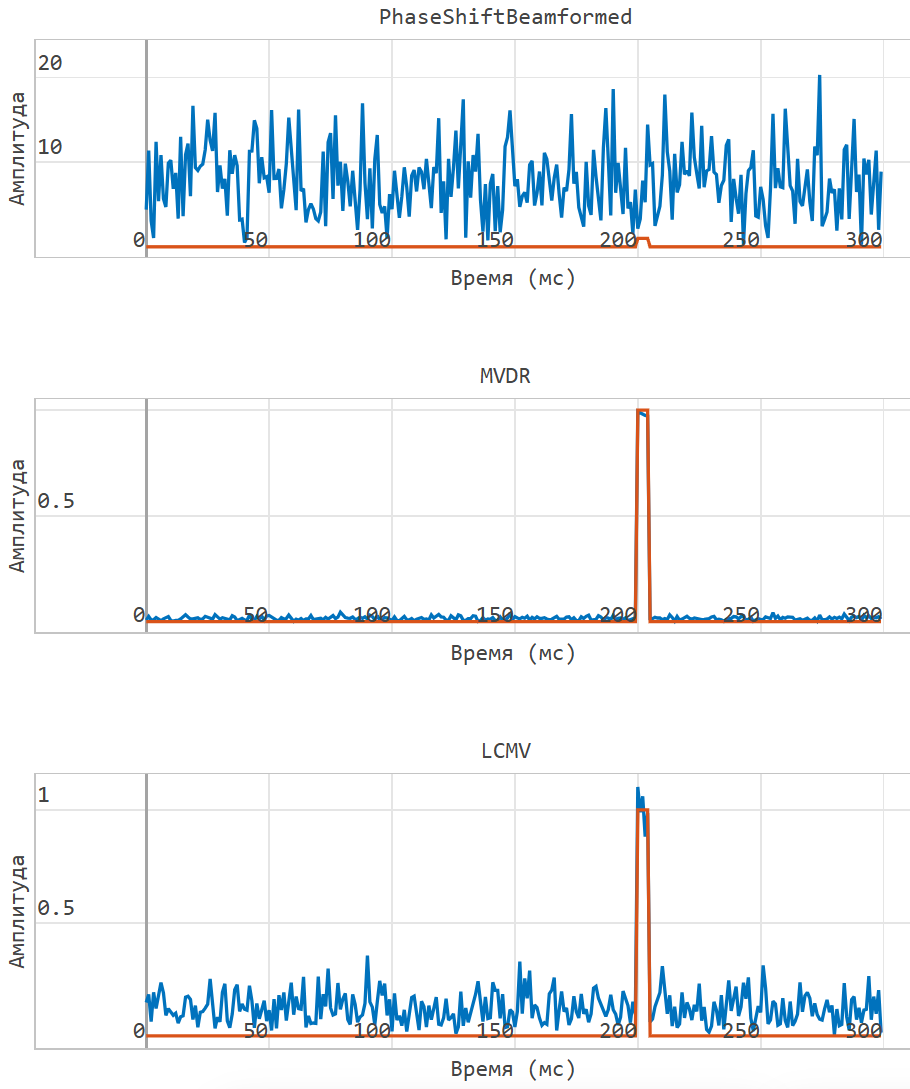Adaptive beamforming when exposed to interference
This example demonstrates the application of adaptive beamforming algorithms MVDR and LCMV under conditions of two interfering signals.
Auxiliary functions
# running a simulation of the system model
function run_model( name_model, path_to_folder ) # defining a function for running the model
Path = path_to_folder * "/" * name_model * ".engee"
if name_model in [m.name for m in engee.get_all_models()] # Checking the condition for loading a model into the kernel
model = engee.open( name_model ) # Open the model
model_output = engee.run( model, verbose=true ); # Launch the model
engee.close( name_model, force=true ); # Close the model
else
model = engee.load( Path, force=true ) # Upload a model
model_output = engee.run( model, verbose=true ); # Launch the model
engee.close( name_model, force=true ); # Close the model
end
return model_output
end;
# reading the output data
function calc_array_out(out, name)
array = zeros(eltype(out[name].value[1]),size(out[name].value[1],1),size(out[name].value[2],2),length(out[name].value))
[array[:,:,i] = collect(out[name].value[i]) for i in eachindex(out[name].value)]
return array
end
# building output graphs
default(titlefontsize=11,top_margin=-1Plots.mm,guidefont=10,
fontfamily = "Computer Modern",colorbar_titlefontsize=8,bottom_margin = -6Plots.mm
)
function plot_result(out, title, number, t_step = 0.3)
t = Vector(0:t_step/size(out, 1):t_step*(1-1/size(out, 1)))*1e3 # time grid in ms
plot(t, out[:, 1, number], label = title, title = title,size=(500,150))
plot!(t, out_ref_pulse[:, 1, number], label = "The reference signal",
xlabel = "Time (ms)", уlabel = "Amplitude (V)"
)
end;
1. Description of the model structure
The model illustrates the formation of a beam in the presence of two interfering signals coming from azimuthal angles of 30 and 50 degrees. The amplitudes of the interfering signals are much larger than the amplitude of the pulse. The noise level is set to -50 dBW to emphasize only the effect of interference. The PhaseShift, MVDR, and LCMV beamforming algorithms are applied to the received signal, and their results are compared.
The structural diagram of the model is based on the example of the [classical beamforming] model (https://engee.com/community/ru/catalogs/projects/formirovanie-lucha-na-fone-shuma ) with the addition of new blocks:
- PSP generator - simulates an interference component with a normal distribution law
- Propagation direction - sets the direction of reception of the useful signal and interference signals in the block Receiving antenna array
- MVDR shaper - implements the MVDR shaping algorithm in a given direction;
- LCMV Shaper - implements the LCMV shaping algorithm with a given weight matrix in a given direction;
The block diagram of the system is shown below.

2. Initialization of model parameters
The model parameters are set in the file ParamBeamformarI.jl using the auxiliary function calcParamBeamformerI. This function is performed once when the model is loaded. It exports a structure to the workspace, the fields of which are referenced by the dialog panels of the model. To change any parameters, either change the values in the structure from the command line, or edit the auxiliary function and restart it to update the parameter structure.
Model Parameters
# Radar parameters
propSpeed = physconst("LightSpeed") # Propagation velocity (m/s)
fc = 100e6 # Carrier frequency (Hz)
lambda = propSpeed/fc # Wavelength (m)
# Antenna Array parameters
numElements = 10 # number of items
ElementSpacing = 0.5*lambda # distance between elements (m)
Antenna = EngeePhased.ULA(numElements=10,ElementSpacing=0.5*lambda)
# Parameters of the probing signal
fs = 1000; # sampling rate of 1 kHz
prf = 1/0.3; # pulse repetition rate (Hz)
# Receiving device
NoisePower = 1/db2pow(50); # Noise Power (W)
Gain = 0.0 # Gain (dB))
LossFactor = 0.0 # Receiver Loss (dB)
# Matrix of weights for LCMV beam shaper
steeringvec = EngeePhased.SteeringVector(SensorArray=Antenna)
cMatrix = steeringvec(fc,[43 45 47])
# connecting a file with model parameters
include("$(@__DIR__)/ParamBeamformerI.jl");
3. Launching the model
Using the function run_model let's run a simulation of the system model Beamformer_Interference. We will write the generated simulation results into a variable out.
out = run_model("Beamformer_Interference", @__DIR__) # launching the model
4. Reading the output data
Using the function calc_array_out counting data from a variable out for each pledged output.
out_ref_pulse = calc_array_out(out, "ReferencePulse") # Reference pulse
out_lcmv = calc_array_out(out, "LCMV") # LCMV Beam Spreader
out_mvdr = calc_array_out(out, "MVDR") # MVDR Beam Spreader
out_phase_shift = calc_array_out(out, "PhaseShift"); # PhaseShift Beam Shaper
5. Visualization of the results of the model
Visualization of the results is possible in two ways:
- in the "graphs" tab (by selecting the "array construction" graph type)
- in a script using the data obtained as a result of the simulation
Using the first method, we visualize the result of the model for outputs with and without ray shaping.:

The figures show the output of 3 preset beam shapers: PhaseShift, MVDR and LCMV. It can be noted that the classical phase shift beamformer does not cope with the task of detecting a target against a background of interference because the interference amplitude is much larger than the useful signal and simply increasing the signal-to-noise ratio is not enough.
The output graph changes if the MVDR and LCMV beamforming algorithm is used: after signal processing, a peak corresponding to the true position of the target is formed.
Similarly, you can visualize the simulation results using the second method. To build it in the script, use the auxiliary function plot_result:
num_puls = length(collect(out["ReferencePulse"]).time) # extracting the last pulse number
plot_result(out_phase_shift, "PhaseShift Mixer", num_puls, t_step) |> display
plot_result(out_mvdr, "The MVDR Mixer", num_puls, t_step) |> display
plot_result(out_lcmv, "LCMV Bleach", num_puls, t_step)
Comparing the resulting graphs, you can see that the resulting images are identical.
Conclusion
In the example, a comparison was made between simple and adaptive beam shapers against the background of a strong interference component. The results showed that the conventional phase shift shaper "PhaseShift Beamformer" is not able to detect a useful signal, in such cases it is necessary to resort to more advanced shaping algorithms "MVDR" or "LCMV"